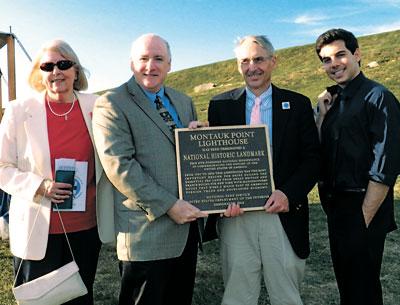Lighthouse Is a National Landmark

“This is even more exciting than I thought it would be,” said Eleanor Ehrhardt, the woman who is credited with spearheading the campaign to get the Montauk Lighthouse declared a National Historic Landmark.
She was speaking on Aug. 22 to a crowd of some 300 invited guests, who were seated under a tent on the Lighthouse grounds for the official ceremony, at which she accepted the historic-landmark plaque from Robie S. Lange, a National Parks Service historian.
A roster of politicians, local clergy, historians, and Lighthouse officials sat in a row on a stage built for the event, overlooking a wide span of the Atlantic. Richard F. White Jr., a Montauk native and the chairman of the Montauk Lighthouse Committee, welcomed the crowd, all of whom had contributed in one way or another to the occasion.
Guest speakers reminisced about their Lighthouse memories, with East Hampton Town Supervisor Bill Wilkinson noting that he had driven from Connecticut to propose to his wife there. “Could you imagine if she said no?” he asked to laughter.
Representative Tim Bishop said he “vaguely” remembered visiting the Lighthouse after his junior and senior proms, which also prompted giggles.
Joe Gaviola, a member of the Lighthouse committee, reminded the crowd that the Lighthouse is lit with thousands of white lights at Christmas. The festive lighting ceremony, which is held over the Thanksgiving weekend, draws several thousand to the community, he said, “and boy, does she look good. We have become Long Island’s Christmas ornament.”
Assemblyman Fred W. Thiele Jr. called Mr. White an exemplar of good citizenship. “If you need anything done in Montauk, all you have to do is call the Montauk Historical Society,” he said.
Gov. Andrew M. Cuomo couldn’t make the event but sent the state’s Suffolk County representative, Scott Martella, who hadn’t yet arrived when Mr. White introduced him as a surprise speaker. Shortly after, he walked down Turtle Hill, looking a bit disheveled before he put on his tie and jacket, and then made a joke about how horrible the traffic was heading out to the easternmost hamlet.
Mr. White asked him if he was returning west right afterward. “If you think getting out here was bad, just wait until you hit the trade parade going home,” he said.
Mr. Martella read a statement from Governor Cuomo, saying in part that “the Empire State is fortunate to be home to many landmarks, and now Montauk is one such landmark.”
The designation is the federal government’s highest level of recognition for a historic site. The Lighthouse was authorized by Congress and President George Washington in 1792 and built in 1796. It was named to the National Register of Historic Places in 1969.
The landmark designation was awarded after a long process, led by the Montauk Historical Society, that began in September 2006 when the Lighthouse committee sent the National Park Service a request that they study the Lighthouse for possible landmark status. The Department of the Interior asked for more information, including a description of the land before and after the Lighthouse was built, construction materials, ancillary buildings, documentation of its importance to navigation, a comparison to other lighthouses, maps, and photos.
In November 2008, Robert J. Hefner, a historical consultant, compiled an expanded draft and sent it to Mr. Lange. The process continued through January 2010, when evidence was submitted that the Lighthouse was the most-important beacon for ships sailing from Great Britain and France to New York with the manufactured goods that were a major part of America’s growing economy.
The National Park Service formally notified Congress in March 2010 that a study was under way to determine the potential of the Montauk Point Lighthouse to be designated a National Historic Landmark. Mr. Hefner prepared a 44-page document compiling all areas of research and submitted it to the National Park System Advisory Committee for formal review a year later.
Two months later, a band of Lighthouse officials including Mr. White, Ms. Ehrhardt, Brian Pope, a site manager, and Mr. Hefner, who gave a PowerPoint presentation, drove together to a meeting in Washington, D.C., where an advisory committee voted unanimously to recommending landmark designation. From there, the application was forwarded to Ken Salazar, secretary of the Department of Interior, who signed on the dotted line and made it official in March.
In presenting the plaque to Ms. Ehrhardt, Mr. Lange noted that the designation makes the Lighthouse eligible for tax cuts and grants. The plaque will be mounted and put on the northwest side of the building.
The event ended on an emotional note when Renee Akkala, accompanied by the Jane Hastings quartet, sang “In Montauk,” which was written by Percy Heath, the jazz bassist who was a longtime resident of the hamlet and a supporter of the Lighthouse. There is a plaque dedicated to him on the Lighthouse grounds right under the historical beacon.
